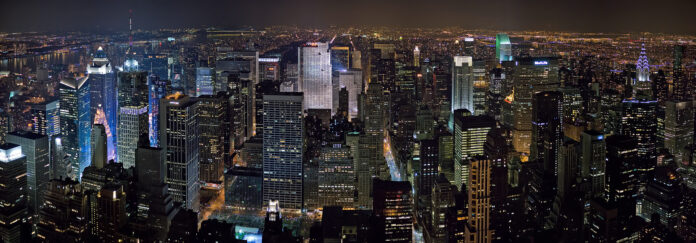It’s difficult to imagine New York City without its skyline of bright lights, but a significantly darker night could become reality in the name of transitioning to a more environmentally friendly city.
City councilman Donovan Richards has proposed legislation that would require property owners of approximately 40,000 commercial buildings to turn off exterior and interior lighting at night, the New York Post reports.The bill excludes small stores and landmarks like the Empire State Building. Building owners who keep their lights on could face a $1,000 fine.
The proposed NYC lighting ban would help the city meet its goal of achieving an 80 percent reduction in greenhouse gases by 2050.
Building owners object to the possible ban, even though it would reduce their electricity bills. At a council hearing, Real Estate Board of New York Vice President Angela Sung Pinsky said that lighting in commercial buildings is important for the city’s productivity and safety. Thousands of building owners would likely seek waivers due to safety concerns.
Alternatively, the legislation has some supporters, including architectural historian Sandy Isenstadt. She argues that the ban has the potential to foster “innovative new lighting schemes.” Advances in technology have reinvented lighting and new ways of producing illumination, and she believes the high-wattage New York skyline to which we are so accustomed will become a thing of the past.
John Lee, deputy director of the mayor’s Office of Sustainability, says the legislation needs to find a balance between environmental goals and adequate lighting as a deterrent against crime.
New York City isn’t the first to propose this type of legislation. Two years after a similar law came into effect there, France is still unable to fully enforce its ban on leaving lights on in unoccupied commercial buildings at night. However, according to the French dark sky association ANPCEN, some municipalities are now saving tens of thousands of euros a year in energy costs as a result of adhering to the practice. On the other side of the equation, France’s lighting industry association, the Syndicat de l’Eclairage, urged their government to focus more on encouraging energy-saving lighting, which could save more energy than simply turning off lights after hours.
New York City could also benefit from promoting energy-efficient lighting, which has potential to be the compromise Lee is seeking. LED lighting uses only a fraction of the energy consumed by traditional energy-hogging light sources. According to the Department of Energy, switching entirely to LED lights over the next two decades could save the U.S. $250 billion in energy costs, reduce electricity consumption for lighting by nearly 50 percent, and avoid 1,800 million metric tons of carbon emissions. Of course, it’s easier to convince building owners to turn off their lights rather than buy entirely new ones.
No matter how this plays out, New York City will likely maintain its bright skyline for the foreseeable future. The proposal is currently backed by only 13 members, only half of the support it needs to pass.



